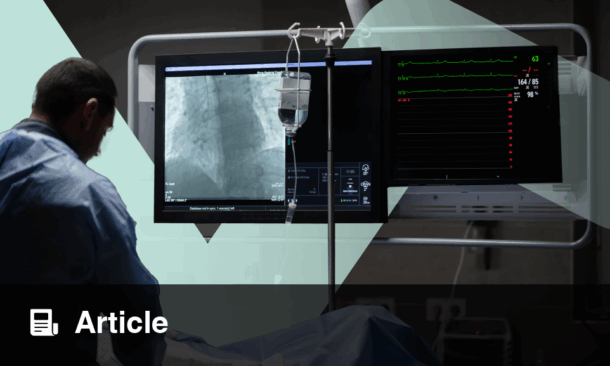Author: *Josip A. Borovac1
1. Division of Interventional Cardiology, Cardiovascular Diseases Department, University Hospital of Split (KBC Split), Croatia
*Correspondence to [email protected]
Disclosure: The author has declared no conflicts of interest.
Keywords: EuroPCR, interventional cardiology, percutaneous coronary intervention, pharmacology, transcatheter aortic valve implantation (TAVR).
Citation: EMJ Int Cardiol. 2025;13[1]:23-27. https://doi.org/10.33590/emjintcardiol/WSHQ8501
![]()
THIS YEAR’S EuroPCR 2025 reached a record-breaking attendance of more than 12,000 participants and introduced a new ‘Complexity Track’, that encompassed catheter-lab reality TV, immersive imaging workshops, and AI, thus sending a ‘complex’ message that a modern interventionalist now needs as many software and technology skills as wire managing skills.
NEWS IN INTRAVASCULAR IMAGING
The headline coronary session was opened with the OCCUPI acute coronary syndrome (ACS) substudy. This study focused on 790 patients with ACS with complex anatomy. It showed that optical coherence tomography (OCT)-guided percutaneous coronary intervention cut the 12-month composite of cardiac death, myocardial infarction, stent thrombosis, or target-vessel revascularisation from 9.5% to 4.9% (hazard ratio: 0.50), compared with plain angiography alone, which was largely driven by fewer periprocedural infarcts.1 Discussants noted that the benefit emerged within 30 days and persisted, echoing earlier bifurcation data, but this time in the emergent ACS setting. This study highlighted the point that was firmly maintained in numerous sessions throughout the congress; intravascular imaging nowadays is a must for the modern interventionalist to improve patient outcomes, and we all need to put in the hard work to increase penetration of these technologies in our everyday cath lab practice.
UPDATES IN INTRAVASCULAR LITHOTRIPSY
Moving forward, two late-breaking trials cemented intravascular lithotripsy (IVL) as the go-to strategy for persistent and refractory calcium deposits. The randomised BALI trial enrolled 200 OCT-defined severely calcified lesions.2 The study showed that IVL lowered the combined endpoint of procedural failure or target-vessel failure to 35.4% versus 51.5% with conventional balloons or atherectomy (relative risk: 0.69; p=0.02) without increasing perforation risk. An all-female EMPOWER-CAD registry then showed 389 women treated with an IVL-first algorithm achieved 90% procedural success and single-digit 30-day adverse events.3 These results were well received in the underserved patient population that typically fares worse with atherectomy. This brings us to the verdict: IVL’s up-front price tag is now outweighed by its predictable safety envelope. Thus far, we have termed the coin ‘rota regret’ in situations where we did not use rotational atherectomy, where in reality, we should now, and we could also add ‘IVL regret’ or ‘not doing IVL when we should have’ to the list.
NOVEL ANTIPLATELET STRATEGIES FOLLOWING ACUTE CORONARY SYNDROME
Korea’s 656-patient 4D-ACS trial took the stage with the focus on the pharmacotherapy arena.4 This important study showed that 1 month of aspirin + prasugrel 10 mg, followed by prasugrel 5 mg monotherapy, significantly cut net adverse clinical events to 4.9% versus 8.8% compared to the standard 12-month regimen. It is important to note that a 49% relative risk reduction was predominantly driven by a 77% drop in major bleeding, with no uptick in death, myocardial infarction, stroke, stent thrombosis, or repeat revascularisation. The data triggered standing-ovation calls to rewrite discharge checklists for any patient whose bleeding risk even vaguely outweighs their ischaemic/thrombotic risk.
UPDATES IN TRANSCATHETER AORTIC VALVE INTERVENTIONS
In the domain of structural cardiac interventions, the cardiac-damage substudy of EARLY-TAVR enrolled 538 asymptomatic patients with severe aortic stenosis, and showed that pre-emptive valve replacement significantly reduced death, stroke, or unplanned cardiovascular hospitalisation across all four stages of baseline myocardial injury, with 86% of patients already exhibiting biomarker evidence of cardiac damage before overt symptom onset.5 Yet, this enthusiasm was tempered 24 hours later by a TriNetX propensity-matched registry of 1,195 patients with a bicuspid aortic valve.6 This study provided sobering data by showing that two-year all-cause mortality was twice as high after transcatheter aortic valve implantation procedure compared to surgical aortic valve replacement, with a hazard ratio of 2.09. This was also accompanied by a doubling of heart failure-related admissions associated with transcatheter aortic valve implantation, thus underscoring that bicuspid aortic valve anatomy still demands surgical respect.
REVIVING THE OLD CONCEPT: ‘UNCAGING’ THE VESSEL
While there seems to be a general sense that, lately, there are no field-advancing studies in the coronary as opposed to structural field, the BIOADAPTOR RCT begs to differ.7 Of note, 3-year data from the 445 patients enrolled in this trial showed the DynamX bioadaptor (Elixir Medical Corporation, Milpitas, California, USA), decreased target-lesion failure to 2.7% versus 7.2% with a contemporary drug-eluting stent (p=0.030). This also reflected on cardiovascular death, which was 0.5% in the bioadaptor arm versus 3.2% in the contemporary drug-eluting stent arm. Benefits were even more pronounced in left anterior descending lesions, hinting that a scaffold which unlocks at 6 months and restores vessel pulsatility might finally deliver on the ‘leave nothing behind’ promise without the late catch-up that doomed bioresorbable vascular scaffolds.
Moving from imaging to physiology, a standing-room‐only symposium previewed the PROVISION study.8 Here, 401 patients were randomised to wire-based fractional flow reserve (FFR) versus non-wire-based CathWorks FFRangio® (CathWorks, Newport Beach, California, USA). At 1 year, major adverse cardiac events were numerically lower with FFR-angio (9.9% versus 12.6%), while saving wires, adenosine, radiation, and about 400 USD per case. Sceptics hammered on the external validity of the study, which has not been proven thus far, but when live demonstrations produced full‐tree colour pressure maps 30 seconds after the final cine run, even the most sceptical were filming with their phones.
APPROACH TOWARDS LEFT MAIN DISEASE ENDORSED
Beyond the headline trials, a joint session by the Latin American Society of Interventional Cardiology (SOLACI)/ Interamerican Society of Cardiology (SIAC), chaired by Latin American cardiovascular societies, unveiled harmonised guidelines for left-main revascularisation that hinge decision-making on intravascular ultrasound-measured minimal luminal area thresholds and an instantaneous wave-free ratio cut-off of ≤0.85, with equal emphasis on surgical risk and heart team consensus. The cross-continental authorship was hailed as a template for global collaboration and evidence appraisal in interventional cardiology.9
VIRTUAL VISIT TO CORONARY BIFURCATION LESION FACILITATED BY VISIBLE HEART TEAM
Personally, the most important teaching moment of EuroPCR 2025 came late Thursday in the Main Arena, where the Visible Heart® team (University of Minnesota Twin Cities, Minnesota, USA) resuscitated a porcine heart inside a transparent perfusion chamber, and streamed real-time 4K angioscopic images.10 Meanwhile, Emmanouil Brilakis and Ryan E. Davies walked the audience through a textbook double kissing-crush procedure for a distal left-main bifurcation. Under the steady narration of anchor Goran Stankovic and analyst Francesco Burzotta, every critical step, namely, side-branch stent deployment, first crush, re-cross with a wire, kissing-balloon inflation, and final proximal optimisation technique, was shown simultaneously via OCT and intracoronary videos. This allowed the packed theatre to see strut deformation and carina shift like never before. The operators used dual Ultimaster Nagomi™ (Terumo Europe, Leuven, Belgium) platforms and deliberately undersized the initial left circumflex artery balloon to provoke discussion on malapposition rescue. Imaging experts Nieves Gonzalo and Thomas Johnson paused the feed twice to measure stent expansion and demonstrate how real-time OCT can avert both elliptical distortion and geographic miss. Maciej Lesiak fielded a torrent of questions on wire re-cross angles, while Paul Iaizzo, guardian of the beating heart, reminded everyone that the model reproduces physiologic shear and flow, making the visual lessons translatable to human cath labs. When the final angiogram showed <5% residual stenosis in both branches, the hall erupted. A standing-room crowd had just watched bifurcation theory turn into living, pulsating reality.
CONCLUDING REMARKS
Taken together, my own ‘to-do list’ on the flight home ran long: I should use OCT and intravascular ultrasound much more, gather more IVL catheters before the next calcified lesion, shorten default dual antiplatelet therapy prescriptions, tighten bicuspid screening protocols, trial FFR-angio in our lab, and schedule a journal club on the BIOADAPTOR RCT. I also learned that the steps of double kissing crush look much uglier and more sobering in real-time angioscopy than on our plain angiography films. I feel that EuroPCR’s unofficial mantra was ‘complex doesn’t mean complicated’ but it certainly means agile. If the week spent at EuroPCR proved anything, it’s that staying current now requires equal parts of mechanical dexterity, digital literacy, and a willingness to ditch dogma at the speed of new data. I’m landing back home in Croatia fully inspired, slightly exhausted, and more convinced than ever that the cath lab of 2026 will look nothing like the cath lab of 2020, and that is exactly what progress should feel like.







